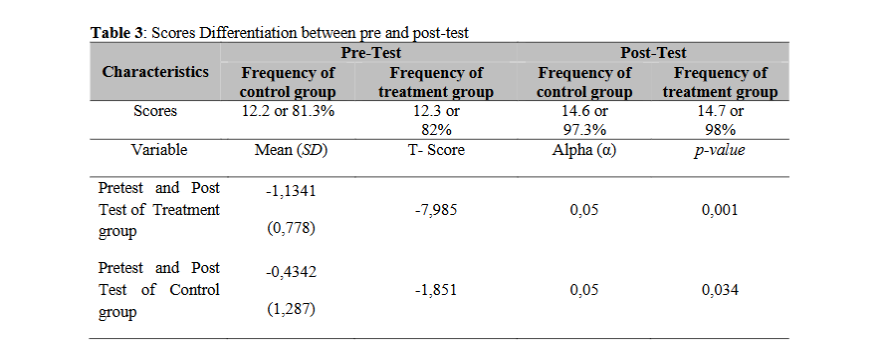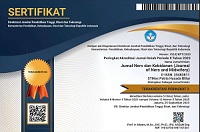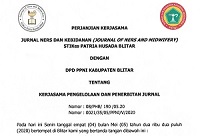Complementary Therapy Training for Teenager in Reducing the Prevalence Rate of Stunting: An Experimental Study
DOI:
https://doi.org/10.26699/jnk.v12i1.ART.p044-050Keywords:
Teenager, Complementary Therapy, StuntingAbstract
It is not yet known precisely which targets and forms of health education can
be used in handling stunting both on a national and global scale. This gap
requires study to find an effective and efficient solution. This research aimed
to examine the target and whether complementary therapy methods, health
education, are appropriate in preventing stunting. This research used
quantitative methods with an experimental design. Carried out in
Gogagoman Village, subdistrict of Kotamubagu Barat of Bolmong Raya,
North Sulawesi. The population was 76 teenagers, and the sample was 50.
The instrument used a questionnaire distributed online. The inclusion criteria
was teenagers who lived in Bolmong Raya. The exclusion criteria was
teenagers who lived outside Bolmong Raya. Primary data was from the
questionnaires, pre and post-tests. The secondary data came from reputable
journals. The training participants were divided into two groups, 25 people
in the treatment group and 25 people in the control group. Data analysis used
SPPS by conducting a paired t-test. The average knowledge value of 25
respondents in the control group after participating in the training increased
by 16%. The treatment group was an increase of 7.3%. This complementary
therapy training, play major role in preventing and overcoming stunting with
a p-value (0.001 and 0.034) < 0.05, which means there is a significant
difference between before and after training. It is recommended that
complementary therapy and health education programs targeting teenagers
in Bolmong Raya, North Sulawesi, be implemented as an effective strategy
for preventing and addressing stunting.
References
Abay Woday; Yonatan Menber; and Delelegn Tsegaye. (2018). Prevalence of and Associated Factors of Stunting among Teenagers in Tehuledere District, North East Ethiopia, 2017. Journal of Clinical & Cellular Immunology, April. https://doi.org/10.4172/2155-9899.100054
Anggraini, Y., & Rusdy, H. N. (2019). Faktor Yang Berhubungan Dengan Stunting Pada Balita Di Wilayah Kerja Puskesmas Air Bangis Kabupaten Pasaman Barat. Dinamika Kesehatan Jurnal Kebidanan Dan Keperawatan, 10(2), 902–910. https://doi.org/10.33859/dksm.v10i2.472
Aqtam, I., & Darawwad, M. (2018). Health Promotion Model: An Integrative Literature Review. Open Journal of Nursing, 08(07), 485–503. https://doi.org/10.4236/ojn.2018.87037
Bach, A., Gregor, E., Sridhar, S., Fekadu, H., & Fawzi, W. (2020). Multisectoral Integration of Nutrition, Health, and Agriculture: Implementation Lessons From Ethiopia. Food and Nutrition Bulletin, 41(2), 275–292. https://doi.org/10.1177/0379572119895097
Brar, S., Akseer, N., Sall, M., Conway, K., Diouf, I., Everett, K., Islam, M., Sylmang Sène, P. I., Tasic, H., Wigle, J., & Bhutta, Z. (2020). Drivers of stunting reduction in Senegal: A country case study. American Journal of Clinical Nutrition, 112, 860S-874S. https://doi.org/10.1093/ajcn/nqaa151
Fitriahadi, E., Priskila, Y., Suryaningsih, E. K., Satriyandari, Y., & Intarti, W. D. (2021). Social demographic analysis with the growth and development of children in the era of the covid-19 pandemic in indonesia. Open Access Macedonian Journal of Medical Sciences, 9, 321–327. https://doi.org/10.3889/oamjms.2021.7389
Halimatunnisa, M., Indarwati, R., Ubudiyah, M., Trihartuty, Martha Sari, N. K. P., & Suhardin, S. (2020). Family Determinants of Stunting in Indonesia: A Systematic Review. International Journal of Psychosocial …, 24(09), 815–822. https://doi.org/10.37200/IJPR/V24I9/PR290099
Hsieh, P. C., Chao, Y. C., Tsai, K. W., Li, C. H., Tzeng, I. S., Wu, Y. K., & Shih, C. Y. (2022). Efficacy and Safety of Complementary Therapy With Jing Si Herbal Tea in Patients With Mild-To-Moderate COVID-19: A Prospective Cohort Study. Frontiers in Nutrition, 9(March), 1–10. https://doi.org/10.3389/fnut.2022.832321
Isak Jurun Hans Tukayo, La Jumu, Yoel Halitopo, Sukatemin, Edison Kabak, & Syaifoel Hardy. (2022). the Integration of Health Student Field Practice in Anthropometry Measurement of Stunting Cases in Papua: a Case Study. International Journal of Social Science, 2(1), 1145–1152. https://doi.org/10.53625/ijss.v2i1.2313
Jersky, M., Titmuss, A., Haswell, M., Freeman, N., Osborne, P., Callaghan, L., Winters, J., Fitzpatrick, S., & Zwi, K. (2016). Improving health service access and wellbeing of young Aboriginal parents in an urban setting: Mixed methods evaluation of an arts-based program. Australian and New Zealand Journal of Public Health, 40, S115–S121. https://doi.org/10.1111/1753-6405.12448
Jumu, L., Jurun, I., Tukayo, H., & Hardy, S. (2022). Maintaining The Sustainable Engagement of Teenager in Family Team of Stunting Prevention Program. 7, 307–312. https://doi.org/10.30604/jika.v7iS1.1296
Khuda, K. E. (2019). Juvenile Delinquency, Its Causes and Justice System in Bangladesh: A Critical Analysis. Journal of South Asian Studies, 7(3), 111–120. https://doi.org/10.33687/jsas.007.03.3097
Korompis, M. D., & Losu, F. N. (2023). Teaching Framework of Stunting for Vocational Midwifery Students : A Document Review. Jurnal Ilmu Kesehatan, 8(1), 145–152. https://doi.org/10.30604/jika.v8iS1.1634
Lusmilasari, L., Aungsuroch, Y., Widyawati, Sukratul, S., Gunawan, J., & Perdana, M. (2020). Nursing research priorities in Indonesia as perceived by nurses. Belitung Nursing Journal, 6(2), 41–46. https://doi.org/10.33546/BNJ.1055
McGlynn, P. J., Renzaho, A. M. N., Pham, M. D., Toole, M., Fisher, J., & Luchters, S. (2018). Critical examination of evidence for the nutritional status of children in Papua New Guinea - a systematic review. Asia Pacific Journal of Clinical Nutrition, 27(1), 1–18. https://doi.org/10.6133/apjcn.042017.02
Mirayanti, N. ketut A., Sukraandini, K., Subhaktiyasa, P. G., Citrawati, N. K., & Candrawati, S. A. K. (2022). Edukasi Pencegahan Stunting dan Manajemen Pola Asuh dalam Pemenuhan Nutrisi pada Balita Melalui Pendekatan Terapi Komplementer. Ahmar Metakarya: Jurnal Pengabdian Masyarakat, 1(2), 90–94. https://doi.org/10.53770/amjpm.v1i2.88
Mustar, Y. S. (2018). Pendidikan Kesehatan: Perilaku Hidup Bersih dan Sehat (PHBS) di Sekolah Dasar. JISIP, 2(2), 1–8. http://journals.sagepub.com/doi/10.1177/1120700020921110
Myatt, M., Khara, T., Schoenbuchner, S., Pietzsch, S., Dolan, C., Lelijveld, N., & Briend, A. (2018). Children who are both wasted and stunted are also underweight and have a high risk of death: A descriptive epidemiology of multiple anthropometric deficits using data from 51 countries. Archives of Public Health, 76(1), 1–11. https://doi.org/10.1186/s13690-018-0277-1
Nasser, M. S. (2022). Child Stunting and Economic Outcomes in SAARC Countries : The Empirical Evidence. 0–42. https://doi.org/10.21203/rs.3.rs-1314101/v1
Primasari, S. P. I. H. N. A. (2023). PELATIHAN TERAPI KOMPLEMENTER UNTUK PENCEGAHAN STUNTING BAGI KADER POSYANDU BALITA DI DESA DUKUN. JURNAL KREATIVITAS PENGABDIAN KEPADA MASYARAKAT, 6(4), 1507–1515. https://doi.org/10.33024/jkpm.v6i4.9217
Purwanti, R. (2019). Peningkatan Kapasitas Kader Posyandu: Cegah Stunting dengan Perbaikan Gizi 1000 Hpk. ETHOS (Jurnal Penelitian Dan Pengabdian), 7(2), 182–189. https://doi.org/10.29313/ethos.v7i2.4430
Puspitasari, A., Putra, W. D., & Amir, H. (2021). Pencegahan Stunting Pada Anak Di Desa Tamangapa Kec. Ma’rang Kab. Pangkep. Idea Pengabdian Masyarakat, 1(1), 05–08. https://doi.org/10.53690/ipm.v1i1.3
Ribek, N., Ngurah, I. G. K. G., Labir, K., & Wardani, K. (2021). Educational Model for Overcoming Stunting Toddlers with Bio Acupressure Massage Using Pure Coconut Oil. Jurnal Pendidikan Dan Pengajaran, 54(2), 390. https://doi.org/10.23887/jpp.v54i2.35837
Sopiatun, S., & Maryati, S. (2021). The Influence of Posyandu Cadre Training on Knowledge and Attitudes in Efforts to Prevent Stunting in Karawang. Proceedings of the 1st UMGESHIC International Seminar on Health, Social Science and Humanities (UMGESHIC-ISHSSH 2020), 585, 514–517. https://doi.org/10.2991/assehr.k.211020.072
Ulfah, I. F., & Nugroho, A. B. (2020). Menilik Tantangan Pembangunan Kesehatan di Indonesia: Faktor Penyebab Stunting di Kabupaten Jember. Jurnal Sosial Politik, 6(2), 201–213. https://doi.org/10.22219/sospol.v6i2.12899
Wirth, J. P., Rohner, F., Petry, N., Onyango, A. W., Matji, J., Bailes, A., de Onis, M., & Woodruff, B. A. (2017). Assessment of the WHO Stunting Framework using Ethiopia as a case study. Maternal and Child Nutrition, 13(2). https://doi.org/10.1111/mcn.12310

Downloads
Published
How to Cite
Issue
Section
License
Copyright (c) 2025 Jurnal Ners dan Kebidanan (Journal of Ners and Midwifery)

This work is licensed under a Creative Commons Attribution-ShareAlike 4.0 International License.


 Poltekkes Kemenkes Manado, Indonesia
Poltekkes Kemenkes Manado, Indonesia Google Scholar
Google Scholar Sinta
Sinta ORCID
ORCID Scopus
Scopus





